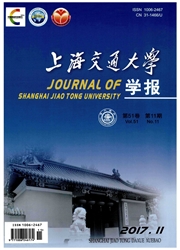

 中文摘要:
中文摘要:
采用曲率半径2μm的金刚石针尖,分别在原子力显微镜和纳米划痕仪上研究了GCr15、304不锈钢、超弹和形状记忆NiTi合金等材料在5μN~80mN载荷的摩擦学性能.结果表明,载荷对材料的摩擦机制有很大影响.当载荷低于80μN时,4种样品表面均无明显的划痕损伤,摩擦机制以界面摩擦为主;100~150μN时,摩擦机制逐渐转变到以犁沟摩擦为主;80mN时,4种材料犁沟摩擦力占总摩擦力的比例甚至超过90%.另外,材料的硬度和弹性模量对其摩擦性能也有显著影响.硬度越高,材料越难发生犁沟损伤,摩擦机制从界面摩擦转变到犁沟摩擦对应的载荷越高;弹性模量与硬度的比值越大,摩擦过程中的犁沟效应越显著,犁沟摩擦力占总摩擦力的比重越大.
 英文摘要:
英文摘要:
By using a diamond tip of 2μm in curvature radius, the tribological properties of GCr15, 304 stainless, superelastic and shape memory effect NiTi alloys were investigated under 5 μN~80 mN with an atomic force microscopy and nano-scratch tester, respectively. The results indicate that the load exhibits a strong effect on the friction mechanism of materials. When the load is below 80 μN, no obvious damage is observed on four samples and the interracial friction should be dominated. While the load increases to 100 ~150 μN, the plough friction becomes dominated. As the load attains 80 mN, more than 90% of the friction force is induced by plough. Also, the hardness and elastic modulus of materials reveal a significant effect on their friction behaviors. The higher the hardness of material, the more difficult to be ploughed the material, and the larger the translation load between interracial friction and plough friction. In addition, when the material has higher ratio of elastic modulus to hardness, the plough should be more dominant during the scratch process.
 同期刊论文项目
同期刊论文项目
 同项目期刊论文
同项目期刊论文
 Nanofretting behaviors of monocrystalline silicon (1 0 0) against diamond tips in atmosphere and vac
Nanofretting behaviors of monocrystalline silicon (1 0 0) against diamond tips in atmosphere and vac Effects of water and oxygen on the tribochemical wear of monocrystalline Si(100) against SiO2 sphere
Effects of water and oxygen on the tribochemical wear of monocrystalline Si(100) against SiO2 sphere Effect of remineralization on the nanomechanical properties and microtribological behaviours of acid
Effect of remineralization on the nanomechanical properties and microtribological behaviours of acid The mechanical properties of the ultrahigh molecular weight polyethylene (UHMWPE) modified by oxygen
The mechanical properties of the ultrahigh molecular weight polyethylene (UHMWPE) modified by oxygen Effect of surface treatment on the fretting wear behavior of medical grade austenitic stainless stee
Effect of surface treatment on the fretting wear behavior of medical grade austenitic stainless stee Effect of surface treatment by ceramic conversion on the fretting behavior of NiTi shape memory allo
Effect of surface treatment by ceramic conversion on the fretting behavior of NiTi shape memory allo Towards a deeper understanding of the formation of friction-induced hillocks on monocrystalline sili
Towards a deeper understanding of the formation of friction-induced hillocks on monocrystalline sili 期刊信息
期刊信息
